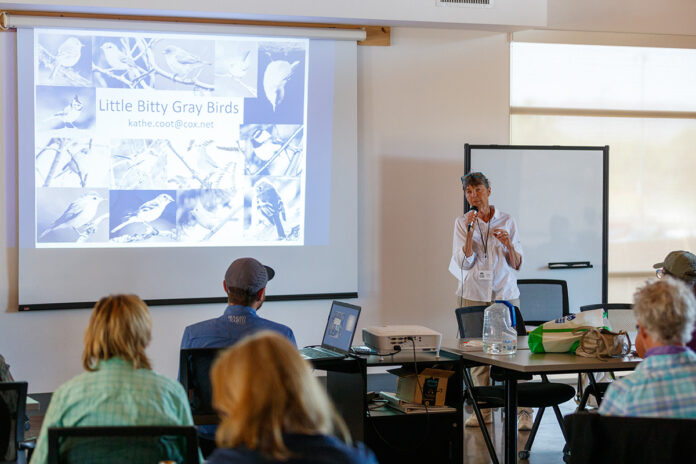Birder Kathe Anderson hosted a workshop on bird identification titled “Little Bitty Gray Birds” on April 27 as part of the Verde Valley Birding and Nature Festival.
Anderson is an avid birder and an active member of the Tucson and Phoenix-area Audubon Societies. She has led hundreds of bird walks for individuals, groups and conservation organizations, and has taught dozens of hands-on birding-related classes for organizations including the Verde Valley Nature and Birding Festival, Arizona State Parks and the Desert Botanical Garden.
Rejecting the notion that Arizona’s birds are predominantly the “drab gray birds of the arid Southwest,” as one birding field guide put it, Anderson instead painted the Verde Valley’s avian denizens as fun and active. She stated they can be categorized either as songbirds or sub-songbirds; songbirds make up about 50% of birds worldwide and are distinguished by the anatomy of their throats.
Anderson highlighted the characteristics and distinguishing traits of a number of local species:
- Hammond’s flycatcher is very active on the branch and can be recognized by its habit of flicking its wings and tail at the same time. The best method for identifying them is usually their song.
- The gray flycatcher is almost identical to the Hammond’s except that its primary flight feathers are not as long and it tips its tail down. This bird usually places its nest in the crotch of a branch next to the tree’s trunk.
- Bell’s vireo is very abundant but not well-studied; these birds are easier to hear than to see. Anderson observed that their chatty song sounds like “which way to Wichita, that way to Wichita.” Birders often set phrases to bird songs so they are easier to remember and identify in the field.
- The mountain chickadee has been more visible in the Verde Valley during the winter, as it travels to lower elevations when its food supply is low.
- The juniper titmouse is very active and acrobatic and lives in pinyon-juniper woodlands. Titmouses are easily recognized by their crests of feathers. Predators such as snakes eat their eggs and nestlings. In response to these threats, juniper titmouses will raise their crests and call harshly or can even hiss like a snake and refuse to move.
- The verdin is a very common desert bird, especially along washes and in suburban areas. Anderson pointed out that many birds actually pant to keep cool in the heat of summer and recommended leaving water out for them.
- Bushtits often help one another with their very elaborate nests and with the care of their young. Anderson shared a video of a “flash mob” of about 20 birds all huddled together sharing a bird bath.
- The pygmy nuthatch, and nuthatches in general, are known for their dexterity, often hanging upside down from branches.
- Lucy’s warblers are one of the earliest spring birds. They are cavity nesters and often build nests in dead trees that are later removed by humans out of fear of fire. Local conservationists are trying to erect triangular nesting boxes to compensate for the bird’s loss of habitat.


